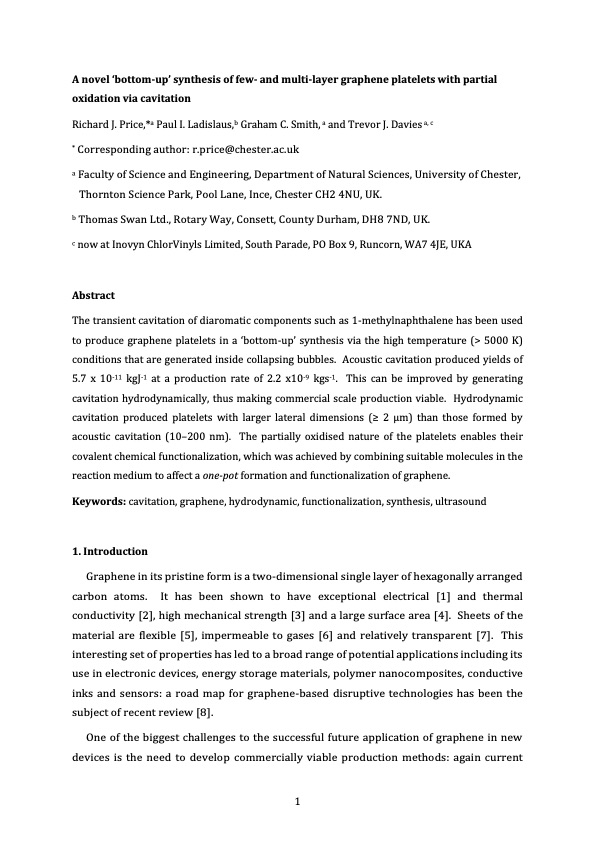
PDF Publication Title:
Text from PDF Page: 002
A novel ‘bottom-up’ synthesis of few- and multi-layer graphene platelets with partial oxidation via cavitation Richard J. Price,*a Paul I. Ladislaus,b Graham C. Smith, a and Trevor J. Davies a, c * Corresponding author: r.price@chester.ac.uk a Faculty of Science and Engineering, Department of Natural Sciences, University of Chester, Thornton Science Park, Pool Lane, Ince, Chester CH2 4NU, UK. b Thomas Swan Ltd., Rotary Way, Consett, County Durham, DH8 7ND, UK. c now at Inovyn ChlorVinyls Limited, South Parade, PO Box 9, Runcorn, WA7 4JE, UKA Abstract The transient cavitation of diaromatic components such as 1-methylnaphthalene has been used to produce graphene platelets in a ‘bottom-up’ synthesis via the high temperature (> 5000 K) conditions that are generated inside collapsing bubbles. Acoustic cavitation produced yields of 5.7 x 10-11 kgJ-1 at a production rate of 2.2 x10-9 kgs-1. This can be improved by generating cavitation hydrodynamically, thus making commercial scale production viable. Hydrodynamic cavitation produced platelets with larger lateral dimensions (≥ 2 μm) than those formed by acoustic cavitation (10–200 nm). The partially oxidised nature of the platelets enables their covalent chemical functionalization, which was achieved by combining suitable molecules in the reaction medium to affect a one-pot formation and functionalization of graphene. Keywords: cavitation, graphene, hydrodynamic, functionalization, synthesis, ultrasound 1. Introduction Graphene in its pristine form is a two-dimensional single layer of hexagonally arranged carbon atoms. It has been shown to have exceptional electrical [1] and thermal conductivity [2], high mechanical strength [3] and a large surface area [4]. Sheets of the material are flexible [5], impermeable to gases [6] and relatively transparent [7]. This interesting set of properties has led to a broad range of potential applications including its use in electronic devices, energy storage materials, polymer nanocomposites, conductive inks and sensors: a road map for graphene-based disruptive technologies has been the subject of recent review [8]. One of the biggest challenges to the successful future application of graphene in new devices is the need to develop commercially viable production methods: again current 1PDF Image | graphene platelets with partial oxidation via cavitation

PDF Search Title:
graphene platelets with partial oxidation via cavitationOriginal File Name Searched:
Sonochemistry-Chester-Rep.pdfDIY PDF Search: Google It | Yahoo | Bing
Salgenx Redox Flow Battery Technology: Power up your energy storage game with Salgenx Salt Water Battery. With its advanced technology, the flow battery provides reliable, scalable, and sustainable energy storage for utility-scale projects. Upgrade to a Salgenx flow battery today and take control of your energy future.
| CONTACT TEL: 608-238-6001 Email: greg@infinityturbine.com | RSS | AMP |